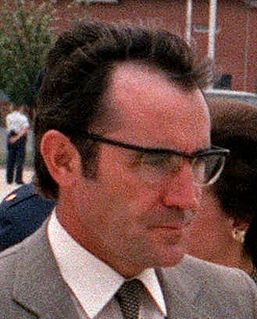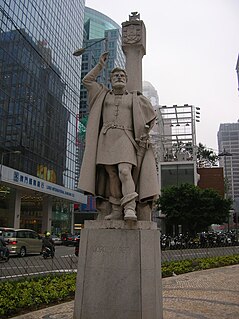
The Portuguese presidential election of 1980 was held on 7 December.

Jorge Álvares was a Portuguese explorer. He is credited as the first European to have reached China by sea during the Age of Discovery.

Brito, real name Hércules de Brito Ruas, is a former Brazilian footballer. He played as a central defender for several clubs, and for the Brazilian national team.

Filipe de Brito e Nicote or Nga Zinga was a Portuguese adventurer and mercenary in Rakhine (Arakanese) service.
Baltemar José de Oliveira Brito is a Brazilian retired footballer who played as a central defender, and a current coach.

Waldemar de Brito was a Brazilian footballer who played as a forward for several clubs in Brazil and Argentina, as well as for the Brazil national team. He is acknowledged to have discovered Pelé during the latter's early footballing days. His brother, Petronilho de Brito, was also a footballer.

Michelle Larcher de Brito is a Portuguese tennis player.
César Gonçalves de Brito Duarte, known as Brito, is a retired Portuguese footballer who played as a striker.
Carlos Luís Cereja de Morais Brito is a Portuguese retired footballer who played as a central defender, and is a manager.

The Siege of Cannanore was a four-month siege, from April to August 1507, when troops of the local ruler, supported by the Zamorin of Calicut and Arabs, besieged the Portuguese garrison at St. Angelo Fort in Cannanore, in what is now the Indian state of Kerala. It followed the Battle of Cannanore, in which the fleet of the Zamorin was defeated by the Portuguese.

The História trágico-marítima is a famous 18th-century collection of narrative accounts of the travails and wrecks of several Portuguese ships, principally carracks (naus) on the India run between 1552 to 1602, and the oft-harrowing stories of their survivors.
João da Silveira was the first Captain of Portuguese Ceylon. Silveira was appointed in 1518 under Manuel I of Portugal. He was succeeded by Lopo de Brito.
Lopo de Brito was the second Captain of Portuguese Ceylon. Brito succeeded João da Silveira and was appointed in 1518 under Manuel I of Portugal, he was Captain until 1522. He was succeeded by Fernão Gomes de Lemos.
Fernão Gomes de Lemos was the third and last Captain of Portuguese Ceylon. Lemos succeeded Lopo de Brito and was appointed in 1522 under John III of Portugal, he was Captain until 1524. In 1524 when he left as Captain, the office was left vacant until 1551, where the office was succeeded by Captain-majors of Portuguese Ceylon.
Miss República Portuguesa or formerly known as "Miss Portugal" is a national beauty pageant in Portugal.
Manuel de Sousa Coutinho was the 14th Captain-major of Portuguese Ceylon. Coutinho was appointed in 1578 under Sebastian of Portugal, he was Captain-major until 1583. He was succeeded by João de Correia de Brito.
João de Correia de Brito was the 15th Captain-major of Portuguese Ceylon. Brito was appointed in 1583 under Philip I of Portugal, he was Captain-major until 1590. He was succeeded by Simão de Brito.
The Siege of the Portuguese fort Santa Cruz de Gale at Galle in 1640, took place during the Dutch–Portuguese and Sinhalese–Portuguese Wars. The Galle fort commanded 282 villages, which contained most fertile cinnamon lands in southern Sri Lanka It was also an important strategic coastal defense of Portuguese Ceylon. The Dutch, who were in an alliance with the Kingdom of Kandy, landed an expeditionary force under Commodore Willem Jacobszoon Coster of Akersloot, at the Bay of Galle, on 8 March 1640. After bombarding the fort for four consecutive days, Dutch troops stormed the fort and secured a victory on 13 March 1640. The Portuguese garrison, led by Captain Lourenço Ferreira de Brito, mounted a stiff resistance and unexpectedly high casualty rates among Dutch troops gave rise to the proverb “Gold in Malacca, lead in Galle”. With this victory the Dutch gained access to a large port which they later used as a convenient naval base to attack Goa and other South Indian Portuguese defenses. They also gained access to the Sri Lankan cinnamon trade and gained a permanent foothold on the island.
Thiago Esmerindo de Souza de Brito, known as Thiago Brito, is a Brazilian professional footballer who plays for Campinense as a forward.








